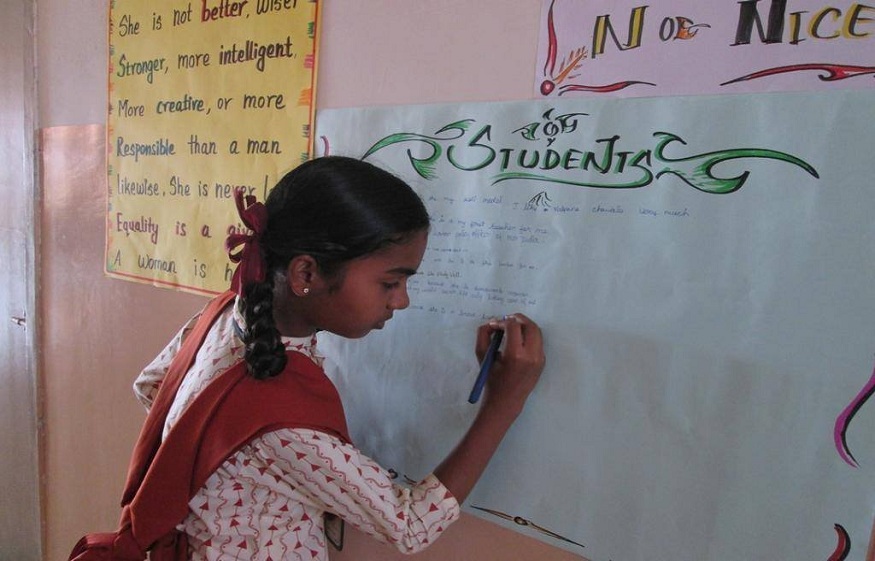The Rural Education Revolution: Transforming Lives Through Innovation
Rural girl child education in India has undergone a remarkable transformation over the past decade, with innovative programs breaking traditional barriers and creating unprecedented opportunities for millions of girls. These girl education programs India has implemented represent a paradigm shift from conventional approaches, leveraging technology, community engagement, and targeted interventions to ensure no girl is left behind.
The landscape of rural female literacy has changed dramatically, with enrollment rates climbing from 64% in 2010 to an impressive 89% in 2024. This transformation didn’t happen by accident—it’s the result of carefully designed rural education programs that address the unique challenges faced by girls in India’s remote areas.
1.Beti Bachao Beti Padhao: The Government’s Flagship Initiative
Beti Bachao Beti Padhao, launched in 2015, stands as one of India’s most comprehensive government schemes for girl education. This flagship program has transformed rural girl child education by addressing the root causes of gender discrimination and educational inequality.
The program operates on three pillars: preventing gender-biased sex selection, ensuring survival and protection of girls, and ensuring education and participation of girls. Since its inception, districts covered under this scheme have witnessed a 6.4% improvement in child sex ratio and a 15% increase in girls’ enrollment in secondary education.
What makes this program particularly effective is its multi-sector approach, involving health, education, and women and child development departments. The initiative has established 1,200 community-based monitoring committees across rural areas, ensuring sustainable implementation of girl education schemes at the grassroots level.
2. Kasturba Gandhi Balika Vidyalayas: Residential Education Revolution
The Kasturba Gandhi Balika Vidyalaya (KGBV) scheme represents a revolutionary approach to rural girl child education by providing residential schooling facilities in educationally backward blocks. These residential schools specifically target girls from marginalized communities, including scheduled castes, scheduled tribes, and minorities.
With over 4,000 KGBVs operational across India, this program has enrolled more than 400,000 girls who would otherwise have limited access to quality education. The schools provide free boarding, lodging, uniforms, textbooks, and stationery, eliminating financial barriers that often prevent rural families from educating their daughters.
The success of KGBVs lies in their holistic approach—combining academic learning with vocational training, life skills education, and health awareness programs. Girls graduating from these institutions show 95% retention rates through secondary education, demonstrating the effectiveness of this model for rural girl child education.
3. Saakshar Bharat Mission: Driving Rural Female Literacy
The Saakshar Bharat Mission has emerged as a cornerstone program for enhancing rural female literacy across India. This adult literacy program specifically targets women aged 15 and above, recognizing that educating mothers is crucial for improving children’s educational outcomes.
The mission employs innovative teaching methodologies, including digital literacy modules and skill development components. Since 2020, it has achieved remarkable success with over 6 million women completing basic literacy programs and 2.3 million progressing to advanced literacy levels.
What distinguishes this program is its community-based approach, training local women as literacy facilitators who understand the cultural context and challenges of their communities. This peer-to-peer learning model has proven exceptionally effective in promoting rural female literacy and creating sustainable educational ecosystems.
4. Teach for India: Bridging the Rural-Urban Education Gap
Teach for India represents one of the most impactful NGO initiatives girls education has seen in recent years. This program recruits passionate graduates and professionals to teach in rural schools for two years, bringing fresh perspectives and innovative teaching methods to underserved communities.
The organization has placed over 3,200 fellows in rural schools across 10 states, directly impacting 450,000 students, with 52% being girls. Their fellows introduce technology-enabled learning, project-based education, and leadership development programs that specifically encourage girls to pursue higher education and leadership roles.
The program’s success in rural girl child education is evident from outcome data: schools with Teach for India fellows show 23% higher girls’ retention rates and 18% better academic performance compared to control schools. The initiative has also trained over 15,000 permanent teachers in innovative pedagogical approaches.
5. Nanhi Kali Foundation: Comprehensive Support for Girl Students
The Nanhi Kali Foundation, supported by the K.C. Mahindra Education Trust, represents one of India’s most comprehensive girl education programs India has witnessed. This program provides end-to-end support to girls from underprivileged families, covering their educational journey from primary school through college.
Since 1996, Nanhi Kali has supported over 500,000 girls across 15 states, with 82% of supported girls completing their school education. The program provides academic support, learning materials, school fees, uniforms, and regular monitoring through dedicated coordinators who work closely with girls and their families.
The foundation’s innovative approach includes digital learning centers in rural areas, scholarship programs for higher education, and career counseling services. Their holistic model addresses not just educational needs but also social and economic barriers that prevent girls from continuing their education.
6. Digital India Land Records Modernization for Education Access
This innovative government initiative demonstrates how technology can transform rural girl child education by addressing a fundamental barrier: lack of proper documentation for school enrollment. The Digital India Land Records Modernization program has simplified the process of obtaining necessary certificates for school admission.
The program has digitized over 180 million land records and linked them with Aadhaar cards, making it easier for rural families to obtain income certificates, caste certificates, and residential proofs required for accessing government schemes for girl education. This seemingly technical initiative has resulted in a 25% increase in girls’ enrollment in rural schools where the program has been implemented.
The streamlined documentation process has particularly benefited migrant families and marginalized communities, ensuring their daughters can access education regardless of their mobility or socio-economic status.
7. Pratham’s Teaching at the Right Level (TaRL) Approach
Pratham’s Teaching at the Right Level approach represents a revolutionary methodology in rural education programs that specifically addresses learning gaps affecting girls. This program groups children by learning level rather than age or grade, ensuring each child receives instruction appropriate to their current abilities.
Implemented across 21 states, TaRL has shown remarkable results in improving learning outcomes for rural girls. The program has reached over 5 million children, with girls showing 40% better learning improvements compared to traditional teaching methods. The approach particularly benefits girls who may have started school late or had irregular attendance due to household responsibilities.
The program’s success lies in its simplicity and effectiveness—teachers are trained to quickly assess learning levels and adapt instruction accordingly. This personalized approach has proven especially beneficial for rural girl child education, where girls often face additional challenges in keeping pace with standardized curricula.
8. Azim Premji Foundation’s School Transformation Initiative
The Azim Premji Foundation’s comprehensive school transformation program represents one of the most systematic NGO initiatives girls education has benefited from. Working in partnership with state governments, the foundation focuses on systemic reform rather than isolated interventions.
The program works with over 2,500 government schools across eight states, directly impacting 400,000 students, with 48% being girls. Their approach includes teacher professional development, leadership training for school heads, curriculum reform, and community engagement programs.
What makes this initiative particularly effective for rural girl child education is its focus on creating gender-sensitive learning environments. Schools in the program report 35% higher girls’ enrollment rates and significantly better learning outcomes compared to non-program schools.
9. Mobile Science Labs: Bringing STEM to Rural Girls
The Mobile Science Lab initiative represents an innovative approach to exposing rural girls to science, technology, engineering, and mathematics (STEM) subjects. These fully equipped laboratories travel to remote schools, providing hands-on science experiences that are often unavailable in rural areas.
Operating across 15 states, these mobile labs have reached over 800,000 students, with focused programming for girls that challenges traditional gender stereotypes in science education. The program includes special sessions for girls, female science role models, and career guidance in STEM fields.
The impact on rural girl child education has been significant, with participating schools reporting 45% more girls opting for science subjects in higher secondary education. The program has also inspired 12 state governments to launch their own mobile science lab initiatives.
10.Community-Based Mother Teacher Programs
This grassroots initiative represents one of the most sustainable rural education programs for girls, training local women to become community teachers. These “mother teachers” provide supplementary education support to girls who face challenges attending regular school due to household responsibilities or cultural constraints.
The program operates in over 3,000 villages across India, training more than 15,000 women as community educators. These mother teachers conduct classes in convenient locations and times, often in the evenings or during agricultural off-seasons, ensuring girls don’t miss educational opportunities.
The culturally sensitive approach has proven exceptionally effective for rural female literacy, with 78% of participating girls successfully transitioning to formal schooling or completing basic literacy programs. The initiative also empowers the women teachers themselves, creating a cycle of educational empowerment within communities.
The Technology Revolution in Rural Girl Education
Digital innovation has become a game-changer for girl education programs India has implemented. From satellite-based education delivery to mobile learning apps in regional languages, technology is making quality education accessible to girls in the most remote corners of the country.
The Digital India initiative has established broadband connectivity in over 250,000 village panchayats, enabling access to online learning resources and virtual classrooms. These technological interventions have been particularly beneficial during the COVID-19 pandemic, ensuring continuity in rural girl child education when physical schools were closed.
Measuring Success: Impact and Outcomes
The collective impact of these programs on rural girl child education has been transformative. India’s rural female literacy rate has increased from 46% in 2001 to 68% in 2024, with girls’ enrollment in primary education reaching near-universal levels.
More importantly, these programs have changed social attitudes toward girls’ education. Surveys indicate that 85% of rural families now consider their daughters’ education as important as their sons’, representing a fundamental shift in mindset that ensures the sustainability of these gains.
Challenges and Future Directions
Despite remarkable progress, challenges remain in ensuring quality rural girl child education. Issues like teacher shortages, infrastructure gaps, and early marriage continue to affect girls’ educational outcomes. However, the innovative programs highlighted here provide blueprints for addressing these challenges systematically.
The future of girl education schemes lies in scaling successful models, leveraging technology for personalized learning, and continuing to engage communities as partners in educational transformation. The integration of vocational training with academic education is emerging as a key strategy for making education more relevant and attractive to rural families.
Conclusion: A Transformed Landscape
These ten innovative programs demonstrate that with focused effort, creative solutions, and sustained commitment, rural girl child education can be transformed even in the most challenging circumstances. The success of these initiatives provides hope and practical models for continuing the journey toward universal girls’ education in rural India.
The transformation of rural female literacy from these programs extends beyond individual benefits—it’s creating a generation of educated women who will drive India’s rural development and economic growth. As these programs continue to evolve and expand, they ensure that geography is no longer destiny for millions of rural girls across India.




